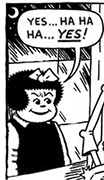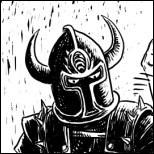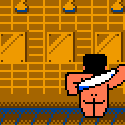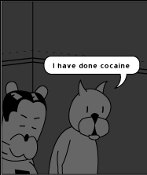|
A Strange Aeon posted:Please keep posting! My favorite part of GMing is fleshing out random table results, so I like seeing what other people come up with. Thanks! I'll definitely keep you posted on this thing as it develops. In the meanwhile, here's one more hex: Hex 0410 is Oyonneux, a walled town. For this town I ruled form of government: syndicracy and ruling class: adventurers. So, it's basically a city ruled by the adventurers' guild! Also, it's main resource is minerals. Trying to make sense of this, I imagined Oyonneux as a once-prosperous mining town that fell on hard times since their mine was invaded by huge spiders! Thankfully, a group of adventurers came in and saved the town, and as it was revealed that the town's mayor had actually been responsible for the spiders (maybe he was a member of some evil spider cult? I don't know) the mayor was run out of town and the adventurers were declared the de facto leaders of the town. The four adventurers have since attracted a number of young adventurers into town to such an extent that Oyonneux's main export in addition to its steady supply of minerals is a large body of young would-be adventurers! (In game terms, a lot of 0-level and 1st-level retainers can be found here!) Anyway, while prepping this game I've started thinking about hit points and natural recovery. BECMI's rules for natural healing are kind of, well, poo poo. 1d3 hit points per a full day of rest. Not only is that painfully slow, it means that a Fighter with 10 hp will have to spend more time recovering to full than a Magic-User with 4 hp. That's really weird and nonsensical, given the abstract nature of hit points. So, I started thinking of a way to tie natural healing rates to a character's maximum hit points, and then it hit me: hit dice! I'm sure this rule has been in some old-school game (might've been World of Dungeons, actually), but the idea is that whenever a character rests they can reroll their hit dice and that's your new total of hit points provided it's more than you started with! This makes hit points a lot more fluid: you don't need to worry about rolling a 1 on your hit dice when you level up, because the next time you get a full night's sleep you'll get to reroll your hit points again! I have no idea as to how this is going to work and whether or not it's a completely dumb idea, but I kind of like it. Will have to think about the exact effects of this with regards to stuff like healing spells as well, though.
|
|
|
|

|
| # ? Jun 5, 2024 22:04 |
|
The cycle is complete, folks: http://www.dndclassics.com/product/28306/ODD-Dungeons--Dragons-Original-Edition-0e With the release of the original 1974 books, every version* of D&D save 5th edition is now legally available in PDF from DrivethruRPG. * nitpickers will fight me about the absence of the Holmes Blue Book, of course, and maybe the Greyhawk supplement to OD&D.
|
|
|
|
Again. I was maybe a month away from emailing and asking them when I'd be able to redownload that. e: It's the new version from the reprint they did, with fancy cover art that doesn't fit at all. The reference sheets are the old poo poo scan, but I don't know how that was handled in the reprint. Also, they still haven't re-released Chainmail. 90s Cringe Rock fucked around with this message at 18:29 on Jan 26, 2016 |
|
|
|
Ratpick posted:I'm personally using the Welsh Piper's Hex-Based Campaign Design things are getting bad when the griffons are reading books on how to deal with their kids
|
|
|
|
Elfgames posted:things are getting bad when the griffons are reading books on how to deal with their kids 
|
|
|
|
Ratpick posted:Anyway, while prepping this game I've started thinking about hit points and natural recovery. BECMI's rules for natural healing are kind of, well, poo poo. 1d3 hit points per a full day of rest. Not only is that painfully slow, it means that a Fighter with 10 hp will have to spend more time recovering to full than a Magic-User with 4 hp. That's really weird and nonsensical, given the abstract nature of hit points.
|
|
|
|
I multiply natural healing rates by the level of the person being healed. I think I would also use a different die for each class as well, based on their hit die. The only issue with doing this however is at the higher levels it can actually outpace magical healing, so there might be some worth in changing that as well.
|
|
|
|
Babylon Astronaut posted:I've always used the "bandage" rule where for each injury you can roll under their con to heal 1d3. The other one you might look at is letting them redeem their hitdice by taking a hitdie in damage to grant bonus's on damage or to-hit or whatnot. Yeah, I started thinking about this as well: RC has rules for bandaging already, the idea being that a successful use of the healing skill after combat recovers 1d3 hit points (but you can only use it to recover injuries received in that combat). Then I started thinking about Hackmaster, which has the system where you track each individual instance of hp loss as an injury, and each separate injury heals at a rate of, I think, 1 hp per day? It sort of achieves what I'm thinking of: A Magic-user brought to 1 hp from 4 in a single attack will take 3 days to recover, as will a Fighter brought from 10 to 1 with three separate 3 damage attacks. It's a bit more involved than what I'm thinking of and I kind of like my aforementioned idea of rerolling your hit dice upon long rests (because it means that your maximum hit points are not a matter of luck upon leveling, but can change from one day to another but always to the benefit of the player). The happy medium between those two would probably be to give every character maximum hp per level, track individual injuries so as to avoid the "Fighter takes longer to heal than a Magic-User of equal level" and then either ramp up the challenge a bit (because the characters can be expected to take a bit more damage now) as well as enforce some time limits. Speaking of time limits, the sandbox I've planned has quite a few potentially developing situations (like the orcs in 2202 who are building a nest) and I was thinking of adopting something similar to fronts from Dungeon World. What do people think is a good rate for escalating a threat in a sandbox type of game? Once per week? So, with the orc situation, after a week they've completed their nest (or dungeon or whatever), then their attacks on 2401 become more and more aggressive after another week, after which they'll mount an attack on 2401 and after a week their siege will end with them razing 2401 and releasing Fenrir. e: Thinking about escalating threats I was reminded of something: in the swamp in 0816 I have a wizard's tower inhabited by a magic-user and their goblin servants. The idea is that the tower is already half-submerged in the swamp, due to the wizard's experimentation on a magical orb (that acts as a conduit to the plane of water) that they stole from an undine in 1107 (I rolled up a monster nest with Planar Monster and with the extra trait of the monster protecting an Enchanted Fountain, so undine made sense). The swamp makes for another great escalating threat: every week of campaigning the swamp grows by 1 hex. The question is, is this an unintended consequence of the magic-user's experimentation (what I originally thought, because the idea of a magic-user who's not really paying attention to their experiments' effects on the surrounding environment sounds appropriate) or does the magic-user actually have some sinister plan behind all of this? Ratpick fucked around with this message at 08:10 on Jan 27, 2016 |
|
|
|
I always vote for "Magic users are blind to consequences" whenever possible.
|
|
|
|
Ratpick posted:So, I started thinking of a way to tie natural healing rates to a character's maximum hit points, and then it hit me: hit dice! I'm sure this rule has been in some old-school game (might've been World of Dungeons, actually), but the idea is that whenever a character rests they can reroll their hit dice and that's your new total of hit points provided it's more than you started with! On the other hand, this means that it will likely take ages to heal those last few hit points once you've got a few levels under your belt. I think using hit dice is generally a good idea, though. Maybe you could heal 1(hit die size) of HP for every day of complete, uninterrupted rest? That would make Fighters and the like heal a lot faster than wizards and rogues, but it could sort of make sense if you think of HP as measurement of general toughness and fatigue as well instead of simply being "meat points".
|
|
|
|
My current retroclone has each class roll their (equivalent of a) Hit Die after each encounter to recover HP, so wizards get back 1d4 and fighters 1d10 - maybe adding their CON bonus too, I haven't decided yet. In-game, it's justified as a mixture of basic first aid, recovering their breath and exulting in victory in the few minutes immediately afterwards. I didn't want to force rests on people (timekeeping isn't an issue in the game), but at the same time I didn't want them to have to rely on magical healing either.
|
|
|
|
Picking through the AD&D 1e DMG, I found that it actually has tables for random generation of overworld/wilderness terrain hexes, and also including sites of interest within said hexes. And then looking through OD&D Book 3, there's also a rule about randomly determining the initial encounter distance between parties and monsters: 2d4 x 10 feet in a dungeon, and then 4d6 x 10 feet out in the wilderness. Finally, looking at Method V more closely, it's always a sequence of 3d6, 4d6, 5d6, 6d6, 7d7, 8d6, 9d6* just arranged differently across the different classes. With all of these little nuggets rediscovered (one might say Unearthed  ), I'm really considering starting an OSR game. The one thing I really don't know how to pull off yet are tricks and traps, and I'm not sure if 66% of the rooms being empty will go well with players. ), I'm really considering starting an OSR game. The one thing I really don't know how to pull off yet are tricks and traps, and I'm not sure if 66% of the rooms being empty will go well with players.* 7 rolls, since they added Comeliness, so I'm thinking you could start at 4d6 going up to 9d6
|
|
|
|
gradenko_2000 posted:The one thing I really don't know how to pull off yet are tricks and traps, and I'm not sure if 66% of the rooms being empty will go well with players.
|
|
|
|
FRINGE posted:If you spend some time fleshing out "what they should have" it keeps it entertaining (and the hoarders love it). Like if you know what the entry was like, where was the kitchen/fire/chimney, dining, etc etc etc Yeah, and the AD&D DMG is a great resource for this types of dressing. There's loads of tables in the back for random dungeon dressing.
|
|
|
|
Also, empty rooms with some details are good because the characters don't know they are empty. There could be traps or treasure or clues or future adventure hooks (graffiti on wall, corpse with note, etc.) But even if they are literally empty, they add interest to a dungeon by allowing the idea of non-set piece encounters. Like, if they are mapping and run into a larger force, they can run back into an empty room and barricade the door or prepare an ambush or hide under the random piles of straw you rolled up. And maybe the room isn't empty when they come back through it because a wandering monster is hanging there now, attracted by the noise. I just hate the idea of dungeons just being encounter after encounter in rooms that have no relation to each other, in dungeons that don't really feel like actual spaces.
|
|
|
|
I like to divide my stuff up 1/3 monsters, 1/3 empty, 1/3 misc. Misc includes things like traps, unguarded treasure, or pretty much anything interactive/designed to be the focus of a scene. I mostly run a megadungon, so I really like just filling it with weird useless tools and hoping the players think of a way to use them--I don't know what they're going to do with a machine that swaps all the blood between two people, but it's almost 100% certain that they'll find some use for it that saves them from a TPK and lets them do something brilliant. Empty rooms are nice because they give you more room for fighting to get weird. If there's an encounter in every room, there's no possibility for either side to really run from the fight without creating just an enormous party-dooming clusterfuck.
|
|
|
|
Has anyone ever found reasonably priced hex graph paper?
|
|
|
|
alg posted:Has anyone ever found reasonably priced hex graph paper? If you don't mind printing the paper yourself, you can create custom-sized hexes at this site: http://incompetech.com/graphpaper/hexagonal/
|
|
|
|
Mian posted:If you don't mind printing the paper yourself, you can create custom-sized hexes at this site: http://incompetech.com/graphpaper/hexagonal/ Oh, nice! Definitely going to print out a sheet from here for my players to use for mapping. Speaking of printing, I've been looking for nice looking character sheets to use with my RC campaign. Most of the characters sheets I've found for Basic D&D wouldn't cut it because they don't have enough room for additional notes (like keeping track of Skills, Weapon Masteries and Spells) but, once again, Dyson Logos delivers: https://rpgcharacters.files.wordpress.com/2009/08/dysons-folder-style-bx-character-sheet.pdf I printed one of those out and it's a perfect combination of form and function: not only is it pretty, but when folded in half it makes a nice little booklet with most of the important stuff on the front page and lots and lots of room for additional notes on the inside. I mean, you'd do well to check out Dyson Logos' stuff anyway, 'cause the guy really knows how to make pretty maps, but he's also got a variety of good-looking character sheets (including a pocketmod B/X character sheet) on his site: https://rpgcharacters.wordpress.com/downloads-games/character-sheets/ Ratpick fucked around with this message at 13:12 on Jan 28, 2016 |
|
|
|
I'm trying to put together a one-page rules summary for my ongoing retroclone, mainly to force me to focus on what still needs working out. The following is what I've got so far. Bearing in mind that the game is an evolution of TAAC (B/X derived, with roll-under mechanics throughout) and is meant for fast one-shot, tournament-style play, the questions are: 1: Do the summarised rules make sense, and are they clear? 2: If not, what needs to be explained better? 3: Are there any other rules that you think should be there? (it's also probably more than one page, but maybe I'll use a small font...) quote:YOU ALL MEET IN A TAVERN
|
|
|
|
I have finally gotten around to reading the Dungeon Crawl Classics pdfs I got from the Kickstarter. Other then a few pbp Shadowrun games I haven't really done any gaming in like 15ish years. I want to try and run a one off game for some of my friends who are in a similar position, some experience with rpgs, but a decade or more ago. I am looking for two things. First, I would love to see a pbp game of DCC. I looked around the gameroom and didn't see anything. Second, I am looking for advice on GMing in general, specifically dungeon crawl stuff. I remember the 1st ed DMG having some good stuff in it, but I am still trying to hunt up an old copy to replace the one I gave away years ago.
|
|
|
|
Payndz posted:I'm trying to put together a one-page rules summary for my ongoing retroclone, mainly to force me to focus on what still needs working out. The following is what I've got so far. Bearing in mind that the game is an evolution of TAAC (B/X derived, with roll-under mechanics throughout) and is meant for fast one-shot, tournament-style play, the questions are: I love how you dealt with surprise, the "preparedness" feature for equipment, and how actions are just "do your one thing". I'd say that it's hard to picture how the attack/damage roll system is going to work out without numbers, and also that I personally would be looking for monster stats, but if it's just a rules summary that got transmitted fairly clearly to me.
|
|
|
|
gradenko_2000 posted:I love how you dealt with surprise, the "preparedness" feature for equipment, and how actions are just "do your one thing".
|
|
|
|
Payndz posted:I'm trying to put together a one-page rules summary for my ongoing retroclone, mainly to force me to focus on what still needs working out. The following is what I've got so far. Bearing in mind that the game is an evolution of TAAC (B/X derived, with roll-under mechanics throughout) and is meant for fast one-shot, tournament-style play, the questions are: It feels a little disjointed in that you use a roll-under for everything except attacks, which is a roll-over-AC. Dungeonslayers, as an example, uses a roll-under mechanic where if you succeed your roll is the damage (so you want the highest roll under your score, and a higher score means both higher chances to hit and higher damage) and the enemies Defense reduces damage, not chance to hit. Maybe switch your mechanic so that everything is a 1d20 roll under, just to make things clearer? You're already converting AC, if instead you treat it as some form of damage resistance it would still be the quick conversion you're looking for.
|
|
|
|
bongwizzard posted:I have finally gotten around to reading the Dungeon Crawl Classics pdfs I got from the Kickstarter. Other then a few pbp Shadowrun games I haven't really done any gaming in like 15ish years. Holler at me for all of the above. I've been a DCC-head for a little while now.
|
|
|
|
Byers2142 posted:It feels a little disjointed in that you use a roll-under for everything except attacks, which is a roll-over-AC. Dungeonslayers, as an example, uses a roll-under mechanic where if you succeed your roll is the damage (so you want the highest roll under your score, and a higher score means both higher chances to hit and higher damage) and the enemies Defense reduces damage, not chance to hit. Maybe switch your mechanic so that everything is a 1d20 roll under, just to make things clearer? You're already converting AC, if instead you treat it as some form of damage resistance it would still be the quick conversion you're looking for. Doing it the Dungeonslayers way would mean using a d20 for all damage rolls (basically making another ability check) rather than the ascending scale I wanted: Sorcerers use a d4 for physical damage, going up through the dice to a Warrior's d10, while high-level monsters can reach multiple d20s. I didn't use damage reduction as I want combat (to me, the boring part of the game) to move as quickly as possible - you can do more damage than your base roll, but not less. BTW, I forgot to include this: quote:Damage Recovery
|
|
|
|
Payndz posted:Yeah, I'd thought about the roll-over discrepancy, but it's not an ability check, just a straight damage score, so higher is better in this case. There are no to-hit rolls; if you make an attack, then you always score damage, no matter what. (The same applies to the monsters, of course, so if you're a Sorceror, Elf or Outlaw, with relatively few HP, you want to stay back in Support as much as possible.) That doesn't come across very well, then, because this section... quote:Each player who makes an attack chooses a target and rolls their Damage Die (DD), the type determined by their class. If the result equals or beats the enemy’s AC, they add any damage bonuses they have to the score. The total damage is deducted from the target’s HP. An enemy with 0 or fewer HP is killed. AP can be used to affect the attack. ...reads like you are rolling to attack. If you don't beat the enemy AC, you don't do damage is how I read that.
|
|
|
|
Byers2142 posted:That doesn't come across very well, then, because this section... An example (numbers made up on the spot): Bob, with STR 17 giving him +2 to damage and a d8 Damage Die, faces an orc with AC4. He rolls 6: the total damage is 8 (6, plus 2 because he beat the AC and his bonus applies).
|
|
|
|
OtspIII posted:I like to divide my stuff up 1/3 monsters, 1/3 empty, 1/3 misc. Misc includes things like traps, unguarded treasure, or pretty much anything interactive/designed to be the focus of a scene. I mostly run a megadungon, so I really like just filling it with weird useless tools and hoping the players think of a way to use them--I don't know what they're going to do with a machine that swaps all the blood between two people, but it's almost 100% certain that they'll find some use for it that saves them from a TPK and lets them do something brilliant. Yeah, you definitely need empty rooms to balance things out - empty rooms just need dressing most of the time to be vaguely interesting still. Like people noted there's tables for dungeon dressing in the 1e DMG, and then there's also the good resources of Frog God Games' Tome of Adventure Design and the Ultimate Toolbox by I forget who. In empty rooms I generally roll a d6 - 1 to 2 is actually empty, 3 to 4 is "common" dungeon dressing, 5 to 6 is unusual dungeon dressing. Couple more tips for using the 1e DMG random dungeon generator because it's one of my favourite things in D&D: 1) Like a lot of stuff in the 1e DMG, there's poo poo organization in this system too. Specifically, it's buried somewhere in the book that only rooms have doors; chambers just have passages leading out of them. This makes them very different spaces in addition to their size, and makes a lot of the generation results make more sense (generate a chamber in a corridor, the corridor obviously just goes through and then you check 30' after because it's still the same corridor.) 2) As Gary says, follow the dice but make sure everything fits. Don't get stuck on an idea that this room is going to be this or that; just mark down that it's a monster and some treasure and come back to it later. The reason is that you may end up generating other rooms or areas around this first one that make it come across quite differently when you have more of your map filled out. Some of the results are very different things in context: a door leading to a 10' by 10' room with a couple exits is one thing, but what about when each of those exits is more 10' by 10' rooms with more exits? Suddenly a small room is a warren, or a maze. Stuff like that. 3) To that end, the DMG generator is very good at filling space but doesn't put things together well. You end up with lots of long, ropey corridors that go around but don't connect things, which works pretty well in giving a mad dungeon feel. You won't end up with something that feels very liveable or encourages good play because it's all cut off from each other, though. What I do is do "punch-throughs" when appropriate. if two corridors roughly meet their ends, connect them feasibly. If two spaces (corridors, rooms, whatever) have a wall between them, roll a d20. On 1-5 there's a secret or one-way door there. You add a bunch more doors but it works a lot better I think. 4) One thing you might not be familiar with is that D&D prior to 3e/2000 used 10' squares, while D&D after that point uses 5' squares. 10' works really well for the random generation system with stuff like the warrens above, but I'd redraw my maps at 5' to use them for actual play in more modern systems. Essentially, 10' is good for an overview, but 5' is good for a really detailed, hands-on map. Up to you which fits your game. 5) Feel free to swap out contents tables to fit your game. Like for the S&W game on Saturdays, I rolled on table V.F. to determine the room contents, but then rolled according to S&W to determine monsters and treasure. Mix and match to see what fits you best.
|
|
|
|
Payndz posted:The number you roll on the Damage Die is the base damage; if you beat the AC, you add any bonuses from STR, buffs, etc on top. I'll rephrase it as something like "If the result equals or beats the enemy’s AC, they add any damage bonuses to the amount of damage rolled." Wouldn't something along the lines of "If you roll equal to or higher than the enemies AC add the remainder to your strength an whatever bonuses as damage." be better.
|
|
|
|
Arivia posted:
All good advice, but I'd take this a step further and say you could consider using a random table from some entire other genre of game, if the fancy strikes you. Why not have a wrecked car or something in a room? I like my dungeons kind of weird like that, so your mileage may vary, but the idea of a bunch of kobolds crashing a car into a wall seems like something that should happen somewhere in dungeonland. And finding a futuristic plasma weapon is cool as well, since anything like that you can limit by ammo or charges to prevent it from being totally OP forever.
|
|
|
|
Elfgames posted:Wouldn't something along the lines of "If you roll equal to or higher than the enemies AC add the remainder to your strength an whatever bonuses as damage." be better. I could make it so everyone gets a minimum +1 damage bonus, but that would mean rebalancing the maths from scratch. (It would also mean that against higher-AC enemies, some characters could only ever plink away 1HP at a time because their Damage Die is smaller than the AC.)
|
|
|
|
Arivia posted:
Note that 3 characters could stand and fight side by side in one 10ft square on a map as well in pre 3E D&d.
|
|
|
|
obeyasia posted:Holler at me for all of the above. I've been a DCC-head for a little while now. I will tonight, thanks!
|
|
|
|
okay so a while ago I found this character sheet, but have never found the game it's for, going off the name I'm guessing it's a Lamentations of The Flame Princess variant, but what can be inferred from the sheet makes it sound interesting, anyone have any idea where I might find out more? https://drive.google.com/file/d/0B6bVySu-Tl0LekZCNGVsOWpGaEU/view?usp=sharing
|
|
|
|
Payndz posted:Some classes won't get melee damage bonuses because they won't have high enough relevant stats, so doing it that way would turn it into a to-hit roll and have the chance of whiffing. Which I want to avoid; every attack should cause damage. ok so i misunderstood. so beating the AC just gives you a damage bonus onto your normal damage dice.
|
|
|
|
Elfgames posted:ok so i misunderstood. so beating the AC just gives you a damage bonus onto your normal damage dice.
|
|
|
|
drrockso20 posted:okay so a while ago I found this character sheet, but have never found the game it's for, going off the name I'm guessing it's a Lamentations of The Flame Princess variant, No. It's a dungeon world hack. Wait, the skill layouts seem to imply that it's inheriting something from Blades In The Dark as well? In any case, it doesn't look good. It would take a miracle to save this patient. Edit: Like this seems like it could be a literal precursor to Blades In The Dark except that the flavor doesn't fit either Into The Wild Blue or Ghost Lines setting at all. DalaranJ fucked around with this message at 20:04 on Jan 30, 2016 |
|
|
|
drrockso20 posted:okay so a while ago I found this character sheet, but have never found the game it's for, going off the name I'm guessing it's a Lamentations of The Flame Princess variant, but what can be inferred from the sheet makes it sound interesting, anyone have any idea where I might find out more? This seems like a completely different beast like DalaranJ said. I don't know about Blades in the Dark but whatever this game is I want to know more, because what little flavor is on show is cool as gently caress.
|
|
|
|

|
| # ? Jun 5, 2024 22:04 |
|
1. Where does the "cold iron has anti-magic properties/is one of the few ways to harm especially magical beings" trope come from? There's references to it as early as AD&D in the Fool's Gold spell and being used against Ghasts, Imps and Lycanthropes, so it must have been in someone's fantasy mythology by the 70s. 2. For all the different polearms that were written about in D&D, it does not deal with sarissa? 3. The AD&D 1e DMG has one set of random encounter tables which uses MM1 monsters, the Fiend Folio has another which uses its own monsters, and the Monster Manual 2 has yet another which uses monsters from all three books. Any idea if any of these in particular are better than the others?
|
|
|


























